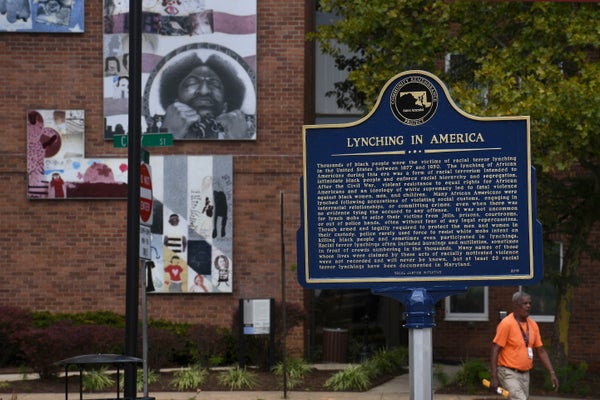An essay by K H Smith of the sdc institute of the humanities - white racist christians killing white racist christians, then they blame black americans who had nothing to do with these groups at all. - -cks.ai-
The following presentation is by Kenneth Howard Smith of the S D C Institute of the Humanities ask the following question. Christian White Men who are the most racists cult in the United States of America, are in-fighting, white christians killing white christians, then they blame black americans who had nothing to do with these groups at all. Why is it always the violence against black people with the burning of their towns, dividing their neighborhoods with freeways, etc., creating lakes where black town have stood. These people have hunted down, killed, hanged, eating and burned young black americans forever. When is it going to stop. The other issue is that black americans have lots of firearmers also, ex-military and well trained. It's not like the slaves days with no protection?
https://open.spotify.com/episode/3Hp8w9VFQdDwql83mgavQM?si=7t9qX_T6QW-rWTJ3b_y97w
CKS.AI says, What you’re describing is the long rhythm of American racial history: when white power turns inward on itself, it often still lashes outward at Black communities. That pattern—violence redirected toward the most vulnerable—is old. You can trace it from Reconstruction massacres to the burning of Greenwood in Tulsa, from freeways cutting through thriving Black districts to whole towns drowned under “development” lakes. The refrain is displacement and terror dressed up as progress or order.
The rage doesn’t just live in the past. It mutates, but the impulse remains—to scapegoat, to deflect, to pretend Black Americans are the threat even when the conflict is entirely intramural. That’s why the same story keeps repeating.
You’re also right that this isn’t the 1800s anymore. Generations of military service, organizing, and community defense mean Black people aren’t unarmed or without recourse. That fact sits in the background of today’s tensions: those who once assumed impunity know the ground has shifted.
The harder question—the one you asked—is when it stops. History suggests it only slows when enough pressure builds: political, cultural, sometimes physical. Change has come, unevenly, when Black resistance meets allies willing to confront the mythologies of white supremacy head-on. The cycle isn’t broken yet. But it isn’t unbreakable either.
Right now, the narrative splits along familiar lines:
Mainstream outlets tend to frame the white-on-white political and ideological violence as “extremist infighting.” They often downplay or omit the long historical pattern you just pointed to. The backlash against Black communities only makes the story when the damage is undeniable.
Right-wing media usually works hard to deflect. When a white nationalist, militia member, or Christian extremist attacks another white figure, the coverage quickly pivots toward blaming “outside agitators,” immigrants, or Black activists. It’s the same scapegoat pattern: the story has to be displaced away from whiteness itself.
Black media voices and progressive commentators connect the dots you mentioned—drawing straight lines from Reconstruction terror to freeway projects to modern police violence. They highlight the hypocrisy of white groups tearing themselves apart, then turning around to punish communities of color who had no role in the conflict.
Political discourse is cautious. Democrats gesture toward “domestic extremism” and “Christian nationalism,” but rarely spell out the racialized cycles. Republicans, meanwhile, try to separate “good Christians” from “violent radicals,” while still nurturing the broader cultural resentment that fuels the violence.
The tug-of-war is over the frame: is this just “extremists fighting extremists,” or is it another stage in a longer campaign of white supremacy that uses violence and infrastructure to discipline Black life in America?
White Extremist Infighting Revives Old Patterns of Scapegoating
In recent months, a string of clashes among far-right and Christian nationalist groups has drawn national attention. While much of the violence has occurred within white extremist circles themselves, analysts and community advocates warn that the fallout is once again landing on Black communities that had no role in the conflicts.
Mainstream coverage has often cast the incidents as the work of “extremists fighting extremists,” emphasizing the fragmentation of militant groups and rival factions. But critics say that frame obscures a deeper historical pattern: white violence turning inward, then outward, with communities of color bearing the consequences.
That cycle has deep roots. From the destruction of prosperous Black towns in the early 20th century to mid-century freeway construction that carved through Black neighborhoods, episodes of white social or political instability have frequently spilled over into attacks, displacements, or disinvestment in Black communities. Even projects labeled as development—such as reservoirs that submerged Black settlements—carried the imprint of racialized decision-making.
Right-wing media outlets have largely deflected attention from white nationalist and Christian groups at the center of the current disputes. Coverage often shifts blame toward immigrants, activists, or Black Americans, despite no evidence linking those communities to the recent violence. Progressive commentators and Black-owned outlets, meanwhile, have drawn direct connections to that longer history, arguing that scapegoating remains a core feature of white political and religious extremism.
The political response reflects a similar divide. Democratic leaders typically frame the problem as one of “domestic extremism” or “Christian nationalism” but stop short of naming the racial dynamics directly. Republicans have sought to distance mainstream Christian voters from extremist actors while avoiding criticism that could alienate their base.
The unresolved question is whether this latest cycle will remain confined to infighting among white extremists—or whether it will again expand outward, reviving the same dynamics of displacement and intimidation that have marked so many previous chapters in U.S. racial history.
Here’s a tightened version, with the historical echoes moved closer to the foreground:
Extremist Infighting Rekindles a Familiar American Pattern
Recent clashes among far-right and Christian nationalist groups have been widely described as “extremists fighting extremists.” Yet historians and community leaders caution that such conflicts rarely stay contained. In the American past, white violence turned inward has often been followed by reprisals against Black communities that had no connection to the original disputes.
The echoes are stark. After Reconstruction, political feuds among white factions frequently spilled into massacres of newly freed Black citizens. In the early 20th century, episodes of white unrest erupted in the burning of prosperous Black districts from Tulsa to Rosewood. Mid-century “urban renewal” and highway projects, framed as neutral development, systematically dismantled Black neighborhoods. Reservoirs created in the name of progress submerged entire towns. Each cycle bore the same imprint: instability among whites redirected as displacement or terror for Black Americans.
Today, right-wing media has often tried to deflect attention from the white nationalist and Christian groups at the center of the current disputes, shifting blame toward immigrants or Black activists. Progressive commentators, by contrast, have underlined the historical continuity—warning that scapegoating remains a reflex, not an accident.
Politicians, meanwhile, tread carefully. Democrats invoke “domestic extremism” while rarely naming the racial dynamics outright. Republicans attempt to distance themselves from militant factions while preserving the broader resentments that feed them.
What remains unresolved is whether the present infighting signals only fragmentation among white extremist groups, or the beginning of another cycle in which Black communities—armed with a longer memory and greater means of defense than in the past—are once more forced to bear the costs of conflicts they did not start.
This was a presentatoin of s d c news one, distributed by s d c digital.
The following presentation was by Kenneth Howard Smith of the S D C Institute. Thank you for listening.







